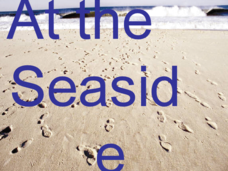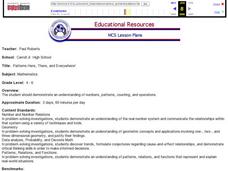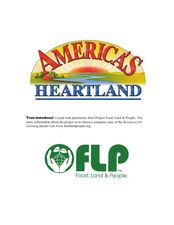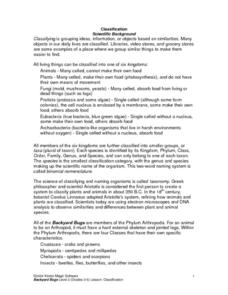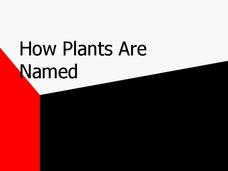Curated OER
At the Seaside
Encourage sorting and classification skills by asking, "What kinds of things are found at the seaside?" Kids sort objects by calling out the items found at the beach. They can choose from things like balls, dogs, bikinis, shells, and...
Curated OER
What Makes a Plant a Plant?
For a plant unit in your biology curriculum, here is a slide show that bestows the basics of plant structure, reproduction, and classification. The information is general. The main point of the lesson is to highlight what characterizes...
Curated OER
Classification of Living Things
Biology learners will be able to explain the binomial nomenclature system and name the seven levels of classification of living things after viewing this set of slides. Brightly colored with bold fonts, the format is eye-catching, and...
Curated OER
Around-The-World-Zoo
Junior biologists design and maintain a website about a zoo by researching, classifying, and providing the correct habitats for the animals they choose to have in their zoo. This technology-based project can last over an entire semester...
Curated OER
Classify Pictures
Classification is an important skill to learn. Here is a worksheet which invites learners to examine three pictures in a row. They circle the picture that does not belong in the row with the other two pictures.
Curated OER
Classifying Pictures 2
Classification is the skill taught in this basic math worksheet. Kindergarteners examine four pictures in a row. They circle the picture that does not belong in the row with the other three pictures.
Curated OER
Classifying and Sorting Pictures
Kindergarteners examine four pictures in a row. They circle the picture that belongs or is a match for the first picture. A basic, yet effective, worksheet on sorting.
Curated OER
Sorting
A lesson on classification and sorting is here for you. Elementary schoolers participate in an interactive computer game in which they sort books by theme. They take a trip to the library to observe and discuss how books are sorted, and...
Curated OER
Patterns Here, There and Everywhere
Pattern recognition is a skill often used in mathematics. Learners count and sort manipulatives, organize the data into a graph and answer questions about the information displayed. They collect the objects to be used and create patterns...
Curated OER
Tree-mendous Game
Students play a game where they classify the different characteristics of trees. In this tress lesson plan, students also use tree vocabulary and describe benefits of trees.
Curated OER
Creative Classroom Creatures
Students are introduced to the five kingdoms and discover why there is a need for a classification system. Using the internet, they examine how scientific names are created and practice putting animals into their correct classification....
Curated OER
Animal Categories
Students sort animal picture cards into classification groups such as mammals, reptiles, amphibians, insects and fish. They discuss the characteristics that each group of animals shares then arrange the pictures into a clasificatioon...
Curated OER
Animal-mania
Students explore the concept of scientific classification systems using a guided Internet research activity. They answer specific questions on the classification of animals by exploring a different Internet link for each question.
Curated OER
Local Animal Sort
Students examine the concepts of sorting and classifying animal. They use familiar animals to determine the connections between physical characteristics and categorization.
Curated OER
Hardware Sort
Students work in groups to sort and classify a variety of hardware materials commonly found in the store. Students discuss attributes and explain their reasoning for different classifications.
Curated OER
Essay Modes: Different Kinds of Essays
Review many different types of essays with this presentation. Each slide gives a short description of an essay such as narrative or persuasive. Makes for a good overview of various formats.
Curated OER
Prokaryotes and Protists
In this Prokaryotes and Protists worksheet, students are given details about the Kingdom Monera and Kingdom Protista. Included are examples of the species in each kingdom, the characteristics of each kingdom and how the species are...
Curated OER
Sink or Float
Third graders sort objects into those they think will float and those that will sink and test their predictions. They experiment with clay molding it into shapes that float. They place pennies in them until they sink. They test other...
Curated OER
Classifying Lesson Plan
Students classify objects according to their similar characteristics.
Curated OER
Living On Earth
Learners discover the many different animals within various habitats and discover how each individual species interacts with its particular environment. Through charting different animals and their distinct habitat and matching animals...
Curated OER
Family Lesson Plan
Kindergarteners discuss families with this resource. They talk about human families, explaining how they grow and change, and focus on vocabulary words. Then, they talk about animal families, discuss the vocabulary involved, and match...
Curated OER
A Tooth for a Tooth
Learners classify mammals as carnivores or herbivores. They look at a set of pictures of animal skulls, observing the shape and size of the teeth, and identify herbivores and carnivores.
Curated OER
Backyard Bugs
Explore the concept of scientific classification and the similarities and differences between plant and animal species. Your class will participate in hands-on activities by investigating dichotomous keys and classifying their shoes. To...
Curated OER
How Plants Are Named
Here is an interesting set of slides that give some nice examples of the reasoning behind scientific Binomial Nomenclature. Some examples of scientific naming are given along with their common names. There is not much more detail on the...


